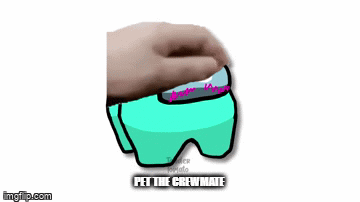


The two aforementioned tools are great if you want to use existing material to create a GIF, but what if you intend to create original content? And then i was like… is just what you’re looking for. This is a powerful tool for any GIF fan and one worth checking out. You can turn a collection of still images into a GIF, for instance, or edit any of the existing GIFs on the website.
#Petpet gif maker download
From there, you can share them, download them directly, or tweak them using a variety of tools. The process doesn’t take long, and the resulting GIFs instantly upload to Giphy. Just pick your source material from YouTube, Vimeo, or Giphy Links, and you can select any portion of the video to turn into a GIF. Giphy’s own GIF Maker lets you simultaneously create and share your creations, and it’s straightforward to use. Giphy has long been the default search engine for GIFs since its library is nearly endless. You can use the provided URL or download the GIF for re-uploading to another site. Once you’re done tweaking things, you’re ready to share your GIF with the world. There are also experimental features like Ping Pong and other effects to play with. Then, add a caption, stickers, and a few effects, if desired. Select the frames you’d like to convert into a GIF using the timeline below the video. Once you’ve picked out your source material, you’ll come to a simple editor.
#Petpet gif maker archive
The site currently supports YouTube, Instagram, and Vine - or rather, Vine archive (R.I.P.) - and users can also upload their own video files. To get started, paste the URL for the video you’d like to use as the basis for your GIF.

Let’s look at the extremely clean and useful, a site that makes creating GIFs incredibly easy to do.

It’s also now nearly effortless to do thanks to these different GIF-maker apps and websites. Making your own GIFs is fun and opens up alternative possibilities. File ( dest, filename = f " -petpet.gif" )) client. seek ( 0 ) # set the file pointer back to the beginning so it doesn't upload a blank file. reply ( 'Please use a custom emoji or tag a member to petpet their avatar.' ) return source = BytesIO ( image ) # file-like container to hold the emoji in memory dest = BytesIO () # container to store the petpet gif in memory petpetgif. read () # retrieve the image bytes else : await ctx. read () # retrieve the image bytes elif type ( image ) = discord. command () async def pet ( ctx, image : Optional ]): if type ( image ) = discord. event async def on_ready (): print ( 'Bot is ready.' ). getenv ( 'DISCORD_BOT_TOKEN' ) client = commands. make ( 'test.png', 'out.gif' )ĭiscord.py example: import os import discord from discord.ext import commands from dotenv import load_dotenv from io import BytesIO from typing import Union, Optional from petpetgif import petpet as petpetgif load_dotenv () token = os. (This parameter correspondsĪnd is passed to the () method.)īasic example: from petpetgif import petpet petpet. (This parameter correspondsĪnd is passed to the () method.)ĭest: A filename (string), pathlib.Path object or a file object. Source: A filename (string), pathlib.Path object or a file object. Usage: from petpetgif import petpet petpet.


 0 kommentar(er)
0 kommentar(er)
